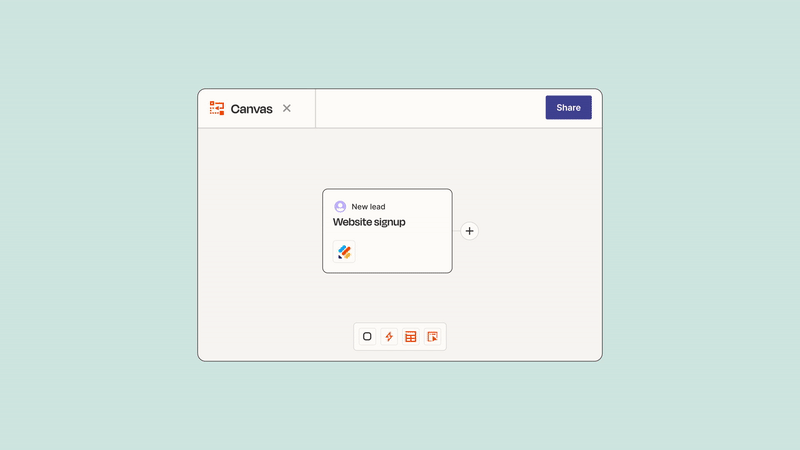TL;DR:
- Zapier introduces Canvas, an AI-powered workflow visualization tool.
- Canvas aims to help users plan and automate complex business processes.
- Tables, Zapier’s automation-first database service, is now generally available.
- Zapier’s evolution from basic connectivity to complex integrations is highlighted.
- Canvas empowers users to map entire workflows, irrespective of Zapier connections.
- AI integration in Canvas generates processes based on user-defined problems.
- Zapier explores generative AI to address intricate business challenges.
- Additional updates include an interactive editor, admin controls, and more integrations.
Main AI News:
In a strategic move to enhance productivity and streamline business operations, Zapier has officially launched Canvas, a cutting-edge tool designed to empower users in planning and visualizing their critical business processes. This innovative solution, currently in early access, incorporates the prowess of artificial intelligence to seamlessly transform these processes into highly efficient Zapier-based automations. The introduction of Canvas aligns perfectly with Zapier’s commitment to delivering comprehensive automation solutions.
Simultaneously, Zapier is thrilled to announce the general availability of Tables, its trailblazing automation-first database service. This expansion of services is a testament to Zapier’s unwavering dedication to providing users with a holistic ecosystem of tools to catalyze their business growth.
As Zapier celebrates its 11th anniversary, the company is hosting the virtual ZapConnect user conference, showcasing its remarkable journey from connecting basic web services to empowering users to construct intricate integrations and workflow automations. Indeed, Zapier was a pioneer in the low-code/no-code landscape long before it became a widespread phenomenon. Wade Foster, co-founder and CEO of Zapier, emphasized the evolution of their platform and its impact on users: “Today, people are building entire projects — and sometimes entire businesses — on top of Zapier. But that has also led to a number of challenges that the company is now trying to address with, among other things, Canvas and Tables.”
The realization that success can sometimes breed complexity prompted the development of Canvas and Tables. Foster elucidated, “Your project starts to grow, and all of a sudden, you’re stitching together all these things, you’re starting to invite collaborators, and things start to get turned into a bit of a hairball. You’re like, ‘oh, no, what am I going to do?’ And Tables and Canvas both fit into helping solve this problem.”
While Zapier’s virtual editor already allows users to visualize interconnected components within Zapier, it only covers a fraction of their workflow. With Canvas, Zapier aims to empower users to map out their entire workflows comprehensively, regardless of their connection to Zapier. Foster explained, “Canvas is a visual diagramming tool where you can start to map out those processes end-to-end. And then the components that Zapier connects to, you can then actually edit those pieces within Canvas. Now, over time, the vision is that you can edit any of the components, whether they connect to Zapier or not, within the Canvas as well.“
Canvas boasts a dual-purpose functionality: users can employ it as a fundamental flowchart diagramming tool for documenting processes, and for the components already integrated with Zapier, it becomes the central interface for editing those processes.
Incorporating artificial intelligence into the equation, Canvas goes beyond conventional visualization tools. Users can specify the problem they intend to solve, and Canvas will autonomously generate a corresponding process, whether it involves planning an elaborate birthday party or addressing a complex business challenge. Additionally, Canvas offers a comprehensive template library to expedite the workflow design process.
Furthermore, Zapier is exploring the integration of generative artificial intelligence (AI) into its services, recognizing the potential of Large Language Models (LLMs) to tackle intricate business problems. Foster shared his perspective on this approach: “LLMs are a good opportunity to go back and look at all the hardest problems you’ve had in your business, the things that you maybe haven’t quite been able to solve yet — and just see if an LLM can make this problem easier to solve.“
In conjunction with the launch of Canvas and the general availability of Tables, Zapier is rolling out several smaller feature updates. Notable additions include a new interactive editor capable of handling up to 10 paths, enhanced administrative controls, and an expanded roster of integrations, now exceeding 6,000 in number. These enhancements underscore Zapier’s unwavering commitment to empowering users with the tools they need to drive efficiency, innovation, and growth in their businesses. Stay tuned for more updates on Zapier’s journey of automation excellence.
Conclusion:
Zapier’s Canvas and the expanded Tables service signify the company’s commitment to simplifying complex workflows. Canvas, with its AI-driven capabilities, will empower businesses to streamline processes, while the integration of generative AI showcases Zapier’s dedication to solving intricate problems. These innovations position Zapier as a leader in the automation market, offering versatile solutions for businesses seeking efficiency and productivity gains.

